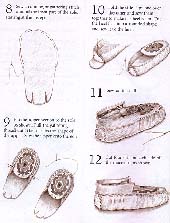|
________________
CM . . . .
Volume VI Number 17 . . . . April 28, 2000
excerpt: Aboriginal peoples learned to use the things they found in nature. Dolls and moccasins were different all across the land depending on what materials were available. Some of the items crafted were necessary for daily life. Other objects were used in ceremonies or as ornaments. Whether it was a bowl or a basket, a drum or a necklace, each thing was precious for the purpose it served as well as the time it took to create it.  Trottier treats her subject matter with great respect, and the book's
subtitle and the "Introduction" excerpt above clearly indicate that the
crafts, 16 in all, are "inspired" by this continent's first peoples and
are not to be considered "authentic" reproductions. Each craft item is
initially introduced by a paragraph which illuminates its original role or
purpose in the culture. For example, the text for the "Bear claw necklace"
explains:
Trottier treats her subject matter with great respect, and the book's
subtitle and the "Introduction" excerpt above clearly indicate that the
crafts, 16 in all, are "inspired" by this continent's first peoples and
are not to be considered "authentic" reproductions. Each craft item is
initially introduced by a paragraph which illuminates its original role or
purpose in the culture. For example, the text for the "Bear claw necklace"
explains:
Shells, animal claws, carved bone and stone were all used for making jewelry. The Cheyenne and Fox made necklaces and leg belts of animal claws, beads and small metal cones. This jewelry was often worn for ceremonies or special meetings. It could show to which clan you belonged or your position among your people, The design might represent an event that occurred in your life.
A "You will need" box then lists the necessary materials, and, it, in
turn, is followed by clear, numbered, step-by-step instructions which are
visually portrayed by Melo's drawings. A full-colour illustration shows
what the finished product might look like. When a step requires adult
help, that fact is indicated.
The crafts range from the decorative, such as seed and bead jewelry,
rosette necklace and beaded bracelet, to the functional, like moccasins,
painted pouch or clay pinch pot. Play items include a bullroarer and clay,
cornhusk and corn cob dolls while the musical side of the culture is
represented by a rasp, turtle rattle and hoop drum.
A map of North America shows the traditional territories of the peoples
named in the book.
A useful addition to school and public libraries, the book should also
find an audience with leaders of youth groups such as Cubs or Guides.
Highly Recommended.
Dave Jenkinson teaches courses in children's and YA literature in the Faculty of Education, the
University of Manitoba.
To comment on this title or this review, send mail to cm@umanitoba.ca.
Copyright © the Manitoba Library Association.
Reproduction for personal use is permitted only if this copyright notice
is maintained. Any other reproduction is prohibited without
permission.
Published by
TABLE OF CONTENTS FOR THIS ISSUE - April 28, 2000.
AUTHORS |
TITLES |
MEDIA REVIEWS |
PROFILES |
BACK ISSUES |
SEARCH |
CMARCHIVE |
HOME
|
